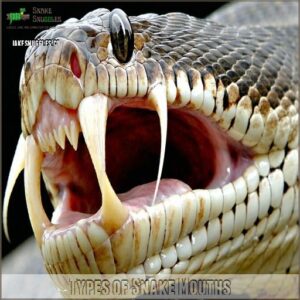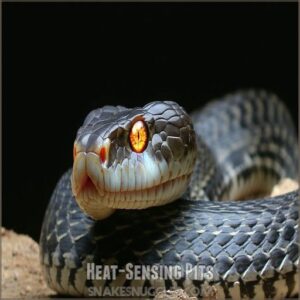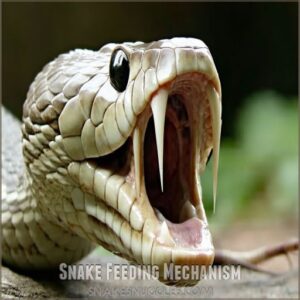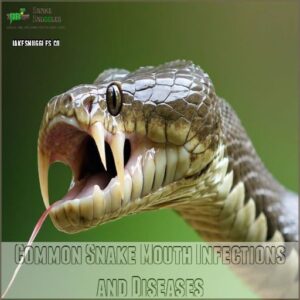This site is supported by our readers. We may earn a commission, at no cost to you, if you purchase through links.

Most non-venomous snakes pack multiple rows of razor-sharp teeth, typically four on top and two below, all angled backward like nature’s fish hooks.
These teeth aren’t for chewing – they’re designed to grip prey with deadly efficiency.
Venomous species take it up a notch with specialized hollow fangs that deliver toxins.
What’s truly remarkable is their ability to replace lost teeth throughout their lives, ensuring they’re always armed and dangerous.
The way these teeth work with their flexible jaws is even more impressive.
Table Of Contents
- Key Takeaways
- What Are Snake Teeth?
- Do Snakes Have Teeth?
- Snake Dentition and Teeth Replacement
- How Snakes Maintain Sharp Teeth
- Snake Jaw and Teeth Function
- Types of Snake Mouths
- Anatomy of a Snake’s Mouth
- Snake Feeding Mechanism
- Snake Venom and Its Effects
- Common Snake Mouth Infections and Diseases
- Frequently Asked Questions (FAQs)
- What are snake teeth?
- Do venomous snakes have teeth?
- What is snake dentition?
- Are snake teeth movable or recurved?
- How do snakes maintain sharp teeth?
- Do all snakes have aglyphous teeth?
- Are Snake Teeth Poisonous?
- How Often Do Snakes Shed Their Teeth?
- Are Snake Teeth as Sharp as Human Teeth?
- How Do Snakes Use Their Teeth to Defend Themselves?
- How Do Snakes Use Their Teeth to Capture Prey?
- Do any snakes have teeth?
- Does a python snake have teeth?
- Do king snakes have teeth or fangs?
- What is the fang of a snake?
- Can snakes feel pain in their teeth?
- Do baby snakes have different teeth than adults?
- How many teeth does an average snake have?
- What happens if a snake breaks its teeth?
- Can snakes regrow damaged or infected fangs?
- Conclusion
Key Takeaways
- You’ll find that snake teeth are specialized tools, varying in structure and function to help grip prey or deliver venom effectively.
- Non-venomous snakes have multiple rows of sharp, curved teeth for gripping, while venomous ones have hollow fangs to inject venom.
- Snakes never run out of sharp teeth because they continuously replace them throughout their lives, ensuring they’re always ready for their next meal.
- Snake jaws aren’t fused and can stretch wide, allowing them to swallow prey much larger than their head size.
What Are Snake Teeth?
You’ll find that snake teeth come in four distinct types: from the basic aglyphous teeth in non-venomous snakes to the hollow solenoglyphous fangs in vipers.
Whether you’re studying a gentle garden snake or a deadly cobra, you’ll discover that each type of tooth serves a specific purpose in the snake’s survival, from gripping prey to delivering venom.
Structure and Function of Snake Teeth
Snake teeth are remarkably specialized natural weapons that have evolved over millions of years.
They come in different types, including aglyphous snake teeth, which are non-fang, sharp, and conical.
You’ll find these teeth are curved backward, helping snakes grip and guide prey toward their throat.
Unlike human teeth, snake teeth aren’t designed for chewing – they’re shaped like sharp hooks for catching and holding prey.
This unique structure prevents prey from escaping once caught.
Types of Snake Teeth
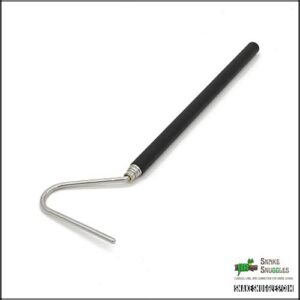 View On Amazon
View On Amazon In nature’s arsenal, snake teeth come in four distinct types, each serving a specialized purpose in their survival toolkit.
- Aglyphous teeth – the simple yet effective grippers found in non-venomous snakes
- Opisthoglyphous teeth – grooved rear fangs delivering mild venom
- Proteroglyphous and solenoglyphous teeth – the advanced hollow fangs of highly venomous species
Importance of Snake Teeth
Understanding how teeth shape a snake’s survival reveals nature’s remarkable design.
These natural weapons serve multiple functions beyond simple biting – they’re sophisticated defense mechanisms and prey capture tools shaped by millions of years of evolution.
You’ll find their specialized dentition enables everything from gripping and subduing prey to delivering venom with precision.
Their bite force and venom delivery systems showcase perfect adaptations for both hunting and defense.
Do Snakes Have Teeth?
You’ll find that snakes have multiple types of teeth, including normal teeth in non-venomous species and specialized fangs in venomous ones.
The arrangement and structure of these teeth directly determine how a snake captures and processes its prey.
Some species have over 200 teeth in their mouths.
Aglyphous Teeth Characteristics
Most non-venomous snakes possess aglyphous teeth – simple, pointed structures that line their mouths like tiny needles.
You’ll find these teeth curved backward, helping to grip and guide prey down the throat.
Think of them as nature’s perfect fishing hooks: they’re solid, relatively small, and scattered across both the upper and lower jaws.
Each tooth serves as an anchor point, making escape nearly impossible.
Solenoglyphous Teeth Function
Solenoglyphous teeth are nature’s perfect venom delivery system.
You’ll find these hollow front fangs in highly venomous snakes like vipers and rattlesnakes.
Think of them as hypodermic needles – they fold back when not in use and spring forward for striking.
The venom flows through these specialized hollow channels, making them incredibly efficient at immobilizing prey.
Each fang connects directly to venom glands, ensuring maximum potency with every strike.
Proteroglyphous Teeth Features
Unlike their cousins with hollow fangs, snakes with proteroglyphous teeth sport grooved front fangs that act like tiny water slides for venom.
You’ll find these in cobras and coral snakes, where the grooves guide venom from special glands right into their prey.
While they’re not as efficient as hollow fangs, these grooved weapons still pack a serious punch and have helped these snakes become successful predators.
Snake Dentition and Teeth Replacement
You’ll be amazed to learn that snakes continually replace their teeth throughout their lives, using a process called polyphyodont dentition.
When you examine a snake’s mouth, you’ll notice multiple rows of teeth at different growth stages, ensuring they’re never without these essential hunting tools.
Polyphyodont Dentition
Snake-tooth biology reveals a fascinating adaptation called polyphyodont dentition, where teeth continuously form throughout their lives.
You’ll find this remarkable system guarantees snakes never run out of their deadly weapons, giving them a significant hunting advantage.
- Multiple tooth generations develop simultaneously in different stages
- Each tooth position has a replacement tooth waiting in reserve
- New teeth form in specialized dental tissues called dental laminae
Tooth Replacement and Shedding
When you examine a snake’s mouth, you’ll notice their remarkable tooth replacement system.
Like a conveyor belt of deadly efficiency, snakes continuously shed and replace their teeth throughout their lives.
| Phase | Duration | Key Features |
|---|---|---|
| Initial Loss | 1-2 days | Old tooth loosens |
| Shedding | 2-3 days | Tooth detaches |
| Gap Period | 3-4 days | Space remains empty |
| Pre-emergence | 4-5 days | New tooth visible |
This continuous cycle guarantees snakes maintain sharp, functional teeth for hunting and feeding.
Regrowth of Teeth Process
The remarkable regrowth of snake teeth happens continuously throughout their lives.
After a tooth falls out, you’ll find the replacement process kicks in immediately.
This process is known as polyphyodonty, where snakes constantly replace teeth every one to three weeks.
Here’s what makes this process fascinating:
- New teeth form in special pockets behind existing ones
- Each tooth takes about 6-8 weeks to fully develop
- Teeth regrow in a synchronized pattern to maintain hunting efficiency
- Up to six replacement teeth can develop simultaneously per position
This constant regeneration guarantees snakes never lose their ability to capture and secure prey effectively.
How Snakes Maintain Sharp Teeth
You’ll be amazed at how snakes maintain their sharp teeth through a continuous replacement process called polyphyodont dentition.
Their specialized jaw structure allows them to control prey effectively while protecting their teeth during feeding, ensuring they’re always ready for their next meal.
Feeding Mechanisms
Feeding mechanisms in snakes reveal nature’s most fascinating adaptations.
You’ll find these remarkable creatures employ specialized techniques for maintaining their dental arsenal.
| Feature | Function |
|---|---|
| Dentition | Continuously replaced teeth |
| Muscles | Control precise bite force |
| Venom | Efficiently delivered through fangs |
| Enzymes | Break down prey tissue |
| Digestion | Complete absorption of nutrients |
These mechanisms work together to keep a snake’s teeth razor-sharp and ready for action, ensuring successful hunting and feeding.
Jaw Structure and Movement
Snake jaws reveal nature’s most remarkable eating adaptations.
You’ll find their lower jawbones aren’t fused together like yours – instead, they’re connected by stretchy ligaments.
This unique structure lets snakes move each side of their jaw independently, creating that signature side-to-side motion while eating.
Their quadrate bones, which connect the skull to the jaw, can rotate considerably outward, enhancing their jaw movement range.
Importance of Jaw Flexibility
Flexible jaws give snakes their legendary ability to swallow prey much larger than their head size.
Building on their complex jaw structure, this remarkable adaptation involves ligaments that stretch like rubber bands during feeding.
This flexibility can be attributed to the unique snake jaw anatomy, which includes a flexible joint at the chin, known as the mandibular symphysis.
You’ll find this impressive feature across all snake species, each fine-tuned to their hunting strategy.
- Jaws can expand up to 150% of their normal size
- Multiple joints work together to create a 130-degree gape angle
- Specialized muscles prevent jaw dislocation during the process
Snake Jaw and Teeth Function
You’ll be amazed to learn that a snake’s jaw doesn’t actually unhinge but instead features incredibly flexible ligaments that allow the bones to spread apart.
Their specialized teeth, which can include up to 30 curved, backward-pointing units per jaw, work together with this flexibility to help snakes grip and gradually swallow prey much larger than their head size.
Number and Placement of Teeth
Now that you’ve seen how teeth stay sharp, let’s look at their fascinating arrangement.
You’ll find varying tooth counts across species, but here’s a quick breakdown of what you’ll typically encounter.
The tooth number and placement can also vary based on a snake’s diet, as some species have unique adaptations such as polyphyodonts constantly replacing teeth.
| Snake Type | Front Teeth | Side Teeth | Back Teeth |
|---|---|---|---|
| Pythons | 4-6 | 15-20 | 12-16 |
| Cobras | 2 fangs | 10-12 | 8-10 |
| Vipers | 2 hollow fangs | 8-10 | 6-8 |
| Grass Snakes | 6-8 | 12-16 | 10-14 |
Myth of Jaw Unhinging Explained
The jaw-unhinging myth you’ve heard about snakes isn’t quite accurate.
Instead of truly "unhinging," snakes have incredibly flexible ligaments connecting their jaw bones, allowing them to stretch their mouths up to six times wider than their head size.
You’ll find that their lower jawbones aren’t fused like ours – they’re connected by elastic ligaments, letting each side move independently.
Role in Controlling Prey
Snake jaws and teeth work together like a perfectly engineered trap.
You’ll find that a snake’s teeth angle backward, creating a one-way grip that prevents prey from escaping.
When hunting, snakes use this combination of jaw strength and tooth structure to maintain complete control.
Their specialized fangs and venom delivery system guarantee that once they’ve got hold of their prey, there’s no letting go.
Types of Snake Mouths
You’ll discover that snakes have evolved three distinct mouth types: constrictors with numerous small teeth, venomous snakes with specialized fangs, and non-venomous snakes with simple teeth for gripping prey.
Each type of snake mouth perfectly matches its hunting strategy, from the powerful grip of constrictors to the precise venom delivery of vipers.
Constrictor Snakes
While constrictor snakes don’t pack the punch of venom, you’ll find their mouths filled with numerous small, recurved teeth designed for a different kind of power.
These aglyphous teeth act like nature’s fishhooks, gripping prey tightly while the snake’s powerful muscles do the heavy lifting.
What’s fascinating is how these teeth, combined with flexible jaws, let constrictors handle prey items larger than their own heads.
Venomous Snakes
Among nature’s most efficient predators, venomous snakes possess specialized fangs that deliver potent venom through two main systems.
Proteroglyphous snakes, like cobras, have fixed front fangs, while vipers showcase solenoglyphous fangs that fold back when not in use.
These natural weapons inject complex venom cocktails that can cause devastating effects, from tissue destruction to nerve paralysis, making antivenom development essential for human safety.
Non-venomous Snakes
Unlike their venomous cousins, non-venomous snakes rely on different hunting strategies and specialized teeth called aglyphous dentition.
You’ll notice these fascinating creatures have multiple rows of small, sharp teeth that curve backward, similar to products displaying snake teeth grip, like those found on reptile grip products.
Here’s what makes them unique:
- They use constriction rather than venom to subdue prey
- Their teeth are designed for gripping rather than injecting toxins
- Most species have six rows of teeth for maximum holding power
Anatomy of a Snake’s Mouth
You’ll find that a snake’s mouth is a marvel of natural engineering, equipped with specialized heat-sensing pits, a remarkable Jacobson’s organ for chemical detection, and incredibly flexible jaws that work together for hunting and feeding.
These unique features let snakes detect their prey’s body heat, process chemical signals from their environment, and swallow animals much larger than their head size.
Heat-Sensing Pits
Heat-sensing pits give certain snakes an incredible superpower – they can detect infrared radiation from warm-blooded prey.
Picture having built-in thermal cameras on your face!
These specialized pit organs, located between the eyes and nostrils, can detect temperature changes as small as 0.003°C.
It’s like having night-vision goggles that let you spot a mouse from across a dark room.
Jacobson’s Organ
The remarkable Jacobson’s organ gives snakes their extraordinary sensory powers, acting like a built-in chemical analyzer. You’ll find this specialized organ in the roof of their mouth, where it processes chemical signals with incredible precision.
Here’s what makes it fascinating:
- Detects prey chemical trails up to several miles away
- Analyzes potential mate pheromones
- Identifies territorial markers from other snakes
- Functions even when the snake’s mouth is closed
Flexible Jaws
Moving beyond chemical detection, flexible jaws give snakes their remarkable feeding abilities.
You’ll find that a snake’s jaw isn’t actually dislocated – instead, it’s connected by incredibly elastic ligaments that stretch wide.
Here’s how different snake species use their jaw flexibility:
| Species | Max Prey Width | Stretching Ability |
|---|---|---|
| Python | 4x head size | Extreme elastic |
| Cobra | 3x head size | Moderate elastic |
| Viper | 2.5x head size | High elastic |
| Grass Snake | 2x head size | Limited elastic |
This incredible adaptation lets snakes swallow prey much larger than their head size.
Snake Feeding Mechanism
You’ll be amazed to learn that snakes can consume prey larger than their own heads using a specialized jaw structure that temporarily disconnects.
Their unique feeding mechanism allows them to swallow animals whole while powerful digestive enzymes break down the meal in their expandable stomachs.
Swallowing Prey Whole
Snakes possess a remarkable ability to consume prey larger than their own head size, thanks to their specialized feeding mechanism.
You’ll find their stomach can expand considerably to accommodate these meals, while powerful digestive enzymes break down the tissue efficiently.
If you’ve ever wondered about choking risks, don’t worry – snakes can actually regurgitate indigestible materials as pellets, making their feeding process surprisingly safe and effective.
Dislocating Jaws
Contrary to popular belief, a snake’s jaws don’t actually "dislocate" – they’re connected by incredibly elastic ligaments that stretch apart.
You’ll find this fascinating adaptation lets them consume prey up to six times wider than their head!
These flexible jaw joints work independently, allowing the snake to walk its skull over its meal through alternating movements of the left and right sides.
Digestive System
After a snake’s jaw manipulation comes the fascinating process of digestion. You’ll witness one of nature’s most efficient digestive systems at work, capable of breaking down entire prey. Utilizing specialized snake digestive enzymes helps dissolve the prey’s skin and muscles, and a wide range of products containing these enzymes can be found at Snake Digestive Enzyme Supplements.
- Your average snake’s stomach can expand up to 3-4 times its normal size
- Powerful digestive enzymes break down everything – bones, fur, and all
- Indigestible materials like feathers or scales get compacted into pellets and regurgitated
This remarkable system lets snakes maximize every meal they catch.
Snake Venom and Its Effects
You’ll find snake venom is a potent mixture of proteins and enzymes that can destroy cells, nerves, and blood vessels within minutes of injection.
When you’re bitten by a venomous snake, these specialized compounds work together to immobilize prey through three main effects: cytotoxins damage cells, neurotoxins attack the nervous system, and hemotoxins break down blood cells.
Composition of Snake Venom
Inside each drop of snake venom lies a complex cocktail of proteins and enzymes that’s evolved over millions of years.
You’ll find a mix of cytotoxins that tear through cell membranes and hemotoxins that wreak havoc on blood cells.
Researchers studying venom composition can find various products and tools online, such as those found in Venom Composition Products.
Surprisingly, this deadly brew has medical applications too – scientists are using venom components to develop treatments for blood clotting disorders and other conditions.
Neurotoxic Effects
Among the deadliest components in snake venom, neurotoxins target your nervous system with devastating precision.
These microscopic assassins disrupt nerve signals throughout your body, leading to progressive paralysis that can start with drooping eyelids and slurred speech.
Within hours, you’ll experience muscle weakness, difficulty breathing, and potentially fatal respiratory failure.
That’s why immediate medical attention isn’t just important—it’s critical for survival.
Hemotoxic Effects
Hemotoxins in snake venom pack a powerful punch against your blood cells.
These specialized toxins break down red blood cells, disrupt blood clotting, and trigger severe hemorrhaging throughout your body.
Unlike neurotoxins that target nerves, hemotoxic venom attacks your circulatory system directly, with viper venom’s composition varying not just between species, but even within populations, showcasing ongoing venom evolution diversity.
You’ll notice symptoms like severe bruising, internal bleeding, and tissue damage.
Treatment requires immediate anticoagulant therapy and specialized antivenoms.
Common Snake Mouth Infections and Diseases
You’ll find that snakes can develop serious mouth infections like stomatitis (mouth rot), which causes inflammation and pus in their oral cavity.
If you’re caring for a snake, you’ll need to watch for signs of snake fungal disease and infectious stomatitis, as these conditions can affect your pet’s teeth, mouth tissues, and overall health.
Mouth Rot (Stomatitis)
When a snake’s mouth becomes inflamed and filled with pus, you’re likely dealing with mouth rot (stomatitis).
This painful condition weakens your snake’s defenses, making feeding difficult and potentially life-threatening.
Look for redness around the gums, excessive saliva, and loss of appetite.
Prompt veterinary treatment with antibiotics is essential, while maintaining proper enclosure hygiene helps prevent future outbreaks.
Snake Fungal Disease
Snake Fungal Disease (SFD) can wreak havoc on your serpent’s health, attacking both skin and mouth areas.
You’ll notice crusty scales, facial swelling, and unusual lesions around their teeth.
This fungal infection, caused by Ophidiomyces ophidiicola, thrives in damp environments and can seriously impact wild and captive snake populations.
Early detection and proper environmental management are key for preventing this potentially devastating condition.
Infectious Stomatitis
Your snake’s health depends heavily on preventing infectious stomatitis, a serious bacterial infection affecting the mouth and gums.
You’ll notice inflammation, redness, and pus formation, which can become life-threatening if untreated.
Treatment typically involves antibiotics and supportive care, including gentle cleaning of the affected area.
Regular check-ups, proper nutrition, and maintaining clean enclosures are essential for prevention.
Frequently Asked Questions (FAQs)
What are snake teeth?
Like tiny daggers in a natural arsenal, teeth in a snake’s mouth come in four distinct types: normal teeth (aglyphous), grooved rear fangs (opisthoglyphous), grooved front fangs (proteroglyphous), and hollow front fangs (solenoglyphous).
Do venomous snakes have teeth?
Beyond just having hollow fangs that deliver venom, you’ll find that venomous snakes have multiple rows of teeth.
Venomous snakes, in addition to their fangs, are equipped with both specialized venom-delivering fangs and regular teeth for gripping prey effectively.
What is snake dentition?
Ever wondered how snakes manage their bite? Snake dentition includes four distinct tooth types: aglyphous (normal teeth), opisthoglyphous (rear grooved fangs), proteroglyphous (front grooved fangs), and solenoglyphous (hollow front fangs).
Are snake teeth movable or recurved?
Snake teeth are indeed both movable and recurved.
You’ll find their teeth curve backward to grip prey effectively,
while special jaw adaptations let them move independently – perfect for swallowing large meals whole.
How do snakes maintain sharp teeth?
Like sharks, your favorite reptile constantly replaces worn or damaged teeth through a process called polyphyodonty.
New teeth develop behind existing ones,
ensuring they’re always sharp and ready for action.
Do all snakes have aglyphous teeth?
While venomous species have specialized fangs, not all snakes possess aglyphous teeth.
Aglyphous teeth are basic, non-grooved teeth.
You’ll find these basic, non-grooved teeth primarily in non-venomous species, which use them for gripping and swallowing their prey whole.
Are Snake Teeth Poisonous?
The teeth themselves aren’t poisonous – it’s the venom glands connected to specialized fangs that deliver toxins.
Venomous species use specialized fangs for venom injection.
You’ll find non-venomous snakes have regular teeth, while venomous species use specialized fangs for venom injection.
How Often Do Snakes Shed Their Teeth?
Snakes continuously replace their teeth throughout their lives, shedding and growing new ones every 6-8 weeks.
You’ll find this process happening row by row, ensuring they’re always ready for their next meal.
Are Snake Teeth as Sharp as Human Teeth?
Razor-sharp fangs in a snake’s mouth make your teeth look like butter knives!
You’ll find their specialized teeth are incredibly sharp, designed for gripping prey and, in venomous species, injecting venom efficiently.
How Do Snakes Use Their Teeth to Defend Themselves?
With specialized fangs and teeth, you’ll find snakes defend themselves through strategic biting. They’ll inject venom, deliver warning strikes, or use their teeth to grip and hold threats when necessary.
How Do Snakes Use Their Teeth to Capture Prey?
Like expert archers, you’ll find these hunters employ specialized teeth formations to grasp and immobilize prey.
They’ll strike swiftly, using recurved teeth that curve backward to prevent escape while they maneuver their catch for swallowing.
Do any snakes have teeth?
Yes, snakes definitely have teeth – four distinct types, actually. You’ll find everything from normal teeth in non-venomous snakes to specialized hollow fangs in vipers that deliver their potent venom.
Does a python snake have teeth?
Pythons pack an impressive 100+ recurved teeth in their mouths.
You’ll find four rows on top and two below – they’re not venomous fangs, but rather small, sharp teeth designed for gripping and holding prey.
Do king snakes have teeth or fangs?
King snakes possess small, sharp teeth rather than fangs.
You’ll find they’re non-venomous constrictors with multiple rows of backward-curved teeth that help them grip and swallow prey whole, without venom delivery.
What is the fang of a snake?
Snake fangs are specialized, hollow teeth that deliver venom through grooves or channels.
Venom is injected during strikes.
You’ll find them in venomous species, where they act like built-in hypodermic needles.
Can snakes feel pain in their teeth?
They don’t feel pain in their teeth because snakes lack dental nerves.
Instead, they sense mechanical pressure through the surrounding tissues.
This allows them to detect changes when using their teeth for hunting or defense.
Do baby snakes have different teeth than adults?
Baby snakes have similar types of teeth as adults, but their size and development stage vary.
Teeth grow with them, adapting for catching smaller prey until they mature into their adult form and capabilities.
How many teeth does an average snake have?
Thousands, maybe millions! Seriously, it depends on the species and age. Adult snakes typically boast dozens to hundreds of tiny, replaceable teeth. Some have fangs, others don’t.
What happens if a snake breaks its teeth?
When a snake breaks a tooth, it isn’t a big deal.
Snakes continuously replace their teeth, thanks to their polyphyodont dentition.
New teeth grow as needed, ensuring the snake’s ability to catch and eat prey.
Can snakes regrow damaged or infected fangs?
Yes, snakes can regrow damaged or infected fangs.
Their teeth, including fangs, are continuously replaced throughout their lifetime.
This process helps them maintain effective venom delivery systems, important for hunting and self-defense.
Conclusion
Think of snake teeth as nature’s perfected tools for survival, much like a poetic dance of precision and power.
These sophisticated weapons guarantee a seamless grip and potent venom delivery, essential for maintaining their top-predator status.
With their continued ability to replace and sharpen these teeth, snakes adapt flawlessly to their environment.
Your newfound understanding of snake teeth should spark respect for these cunning hunters, whose dental arsenal is as fascinating as it’s lethal.
- https://www.chem.fsu.edu/chemlab/chm1020c/Lecture%2010/01.php
- https://www.livescience.com/7551-snakes-fangs.html
- http://www.fileden.com/files/2008/1/6/1683128/Nwjz/vol4/03.nwjz.04.01.Arikan.et.al..pdf
- http://jeb.biologists.org/content/108/1/247.full.pdf
- http://www.ncbi.nlm.nih.gov/pmc/articles/PMC298212/pdf/pnas00287-0398.pdf








